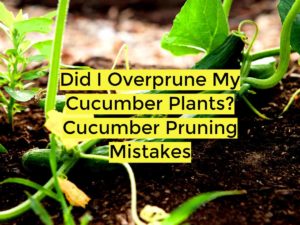Cucumbers thrive in warm climates and moderate rainfall. They are a popular choice for home gardeners. However, making sure that your cucumber plants receive just the right amount of water is essential for their health and productivity. Overwatering is a common mistake that can lead to a host of problems, affecting the overall vigor and yield of your plants. In this in-depth article, we will explore how to know if a cucumber plant is overwatered, the steps to fix the issue, and best practices for watering your cucumber plants to keep them thriving through the season.
What do overwatered cucumber leaves look like?
Spotting the signs of overwatering is crucial for timely intervention. Overwatered cucumber plants exhibit several distinctive symptoms:
Yellowing leaves
One of the earliest ways to know that a cucumber plant is overwatered is the appearance of yellowing leaves.
The yellow color usually starts at the bottom leaves and progressively moves up the plant. This yellowing occurs because the roots of the cucumber plant become stressed due to excess water.
When the soil remains constantly wet, the root system struggles to uptake essential nutrients effectively, leading to nutrient deficiencies that manifest as yellow leaves.
Wilting leaves
Interestingly, overwatering can cause leaves to wilt, even when the soil is consistently moist. This can be confusing for gardeners because wilting is often associated with drought or underwatering.
However, when a cucumber plant is overwatered, the roots become waterlogged, reducing their ability to take in oxygen from the soil.
As a result, the leaves can wilt due to reduced transpiration and nutrient uptake, even when there is plenty of water in the soil.
Mold or mildew
Overly moist conditions around the leaves and stems create a favorable environment for fungal growth. If you notice fuzzy, white, or gray patches on the leaves, it may indicate that your cucumber plant is overwatered. These fungal infections can further weaken the plant and hinder its growth and productivity.
Drooping and mushy stems
Overwatered cucumber plants may exhibit soft, mushy stems that appear weak and droop instead of standing upright. The mushiness is a result of waterlogged cells in the stems, causing them to lose structural integrity. As a consequence, the plant struggles to hold itself upright, and the stems may bend or droop, making the cucumber plant look unhealthy.
Stunted growth
Overwatering can lead to root rot, which damages the delicate root system and affects the plant’s ability to absorb water and nutrients effectively. As a result, the cucumber plant’s growth is impeded, and it fails to reach its full potential.
How do you fix an overwatered cucumber plant?
If you suspect your cucumber plant is suffering from overwatering, take prompt action to rectify the issue and revive your plant’s health:
Assess the soil
Check the soil’s moisture level by inserting your finger about an inch into the soil. If it feels excessively damp, hold off on watering until the top inch of the soil dries out. This allows the roots to access oxygen and recover from the waterlogged conditions.
Improve drainage
Ensuring proper drainage in the cucumber’s planting area is essential. If the soil retains water for prolonged periods, it may be necessary to amend it with organic matter or compost. Adding organic materials can improve soil structure and increase its ability to drain excess water, reducing the risk of waterlogged roots.
Adjust your watering routine
Instead of watering on a fixed schedule, water your cucumber plant as needed. Only water when the top inch of the soil feels dry to the touch. This practice encourages the plant’s roots to grow deeper in search of water, making them more resilient during dry spells.
Use a watering gauge
For a more precise approach to watering, consider using a soil moisture meter or a watering gauge.
A watering gauge is a cool way to know if a cucumber plant is overwatered. These tools allow you to measure the soil’s moisture level accurately, guiding you on when and how much to water your cucumber plants.
Trim affected leaves
If some leaves have turned yellow or developed mold, carefully prune them to prevent further spread of the issue. Pruning these damaged leaves not only improves the plant’s appearance but also prevents the spread of fungal diseases and redirects the plant’s energy to healthier parts, facilitating its recovery.
Should cucumbers be watered every day?
The watering frequency for cucumber plants depends on several factors, including weather conditions, soil type, and the growth stage of the cucumber plant. Instead of following a rigid daily watering schedule, it is best to adopt a more nuanced and informed approach.
Check the soil
Always check the soil moisture level before watering. Stick your finger into the soil and water only if the top inch feels dry. This ensures that you water your cucumber plants when they truly need it.
Water deeply
When you water your cucumbers, do it deeply and thoroughly. This encourages the plant’s roots to grow deeper into the soil in search of moisture and nutrients. As a result, the plant becomes more resilient during dry periods, as its deep roots are better equipped to access water stored at greater depths.
Use mulch
To conserve soil moisture and reduce the frequency of watering, consider using organic mulch, such as straw or wood chips, around the cucumber plants. Mulching helps retain soil moisture by reducing evaporation and also suppresses weed growth, which can compete with your cucumber plants for water and nutrients.
What does underwatered cucumbers look like?
While overwatering can pose significant challenges to cucumber plants, underwatering is equally detrimental to their health and productivity. Recognizing the symptoms of underwatering can help you intervene before the situation worsens.
Drooping leaves
One of the primary signs of underwatering is drooping leaves. As a survival mechanism, cucumber plants tend to conserve water during dry periods by reducing transpiration. This leads to the leaves appearing limp and droopy, even after watering. When you notice this symptom, it is crucial to water the plant promptly to replenish its water reserves and prevent further water stress.
Dry and crispy leaves
Underwatered cucumber leaves may also become dry and crispy, with edges browning and curling. The lack of water affects the plant’s ability to carry out essential processes like photosynthesis, resulting in the leaves drying out. In severe cases, the leaves may start to wilt and eventually dry up entirely.
Slow growth
Moreover, underwatered cucumber plants often exhibit slow growth and reduced yield. Without an adequate water supply, the plant cannot access the nutrients it needs to grow and produce fruit. As a result, the cucumber plant’s growth becomes stunted, and you may notice smaller fruits or a diminished harvest.
Conclusion
Maintaining the right balance in watering your cucumber plants is vital for their health and productivity. Both overwatering and underwatering can have adverse effects on your cucumber plants, impacting their growth, yield, and overall well-being.
To ensure your cucumber plants thrive, be attentive to the signs of overwatering, including yellowing leaves, wilting, mold, drooping stems, and stunted growth. If you observe these symptoms, take immediate action to adjust your watering practices.
To fix an overwatered cucumber plant, assess the soil’s moisture level, improve drainage, adjust your watering routine, and use tools like watering gauges or soil moisture meters for precision. Trim affected leaves to prevent the spread of issues and encourage recovery.
Avoid rigid watering schedules and instead check the soil’s moisture level before watering. Water deeply and thoroughly to promote deeper root growth and increased resilience during dry spells. Consider using mulch to retain soil moisture and suppress weeds, optimizing water usage. Remember that a well-watered cucumber plant is a happy and productive cucumber plant. Happy gardening!




